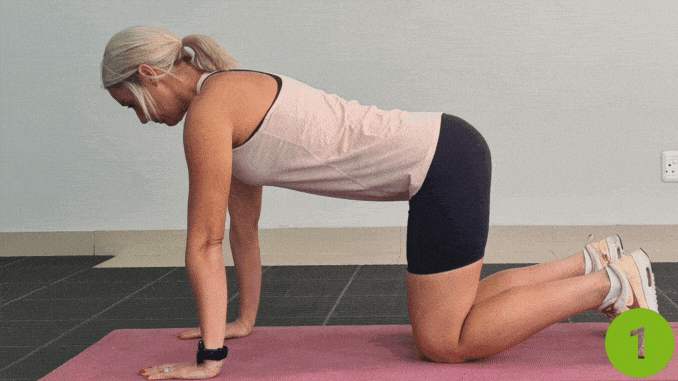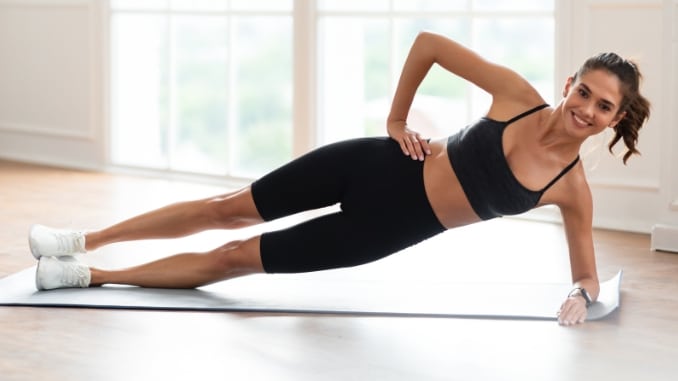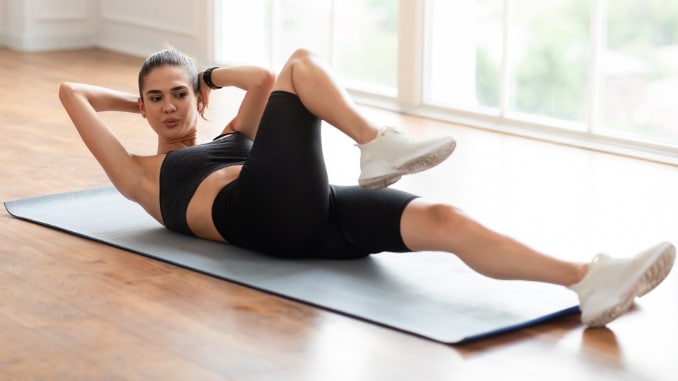If you’ve been doing traditional crunches or sit-ups and feeling discomfort in your lower back, you’re not alone.
While ab exercises [1] are essential for core strength, not all are created equal, especially when it comes to protecting your spine. Many people unknowingly sacrifice form for intensity, which can lead to soreness, strain, or even injury.
The good news? You can still build strong abdominal muscles without wrecking your back.
Let’s dive into the safe crunch exercise—a smart modification known as the curl-up. It’s ideal for strengthening your core muscles, engaging the rectus abdominis [2] and transversus abdominis, and protecting your spine at the same time.
How to Do the Curl-Up: Step-by-Step Instructions
This safer version of the crunch is a game-changer, especially for older adults, beginners, or anyone recovering from injury.
Starting Position:
- Lie on your back on a mat or carpeted floor.
- Extend your right leg straight. Keep your left knee bent with your right foot flat on the floor. (This locks your pelvis to prevent excess motion.)
- Place your left hand underneath your lower back. This helps maintain a neutral position and protects your spine’s natural curve.
- Rest your right hand behind your head, fingertips gently touching, to support your neck and keep your head aligned with your spine.
The Movement:
- Slowly lift your head off the floor, engaging your core muscles. Focus on movement from the mid-back rather than the lower back.
- For more intensity, lift your shoulder blades slightly off the ground while maintaining good form.
- Want an advanced exercise? Hold the lifted position for 1–2 seconds before lowering back down with control.
Important Tips:
- Maintain steady tension in your core.
- Don’t yank on your neck—use your abs to lift, not your arms.
- Keep one knee bent, one leg straight, and your lower back supported.
Repeat for 8–15 reps, rest, and switch sides (bend the left knee, straighten the right leg, and switch arms).
Complementary Core Exercises to Strengthen Without Strain
In addition to the curl-up, try adding these core exercises to your routine for well-rounded strength and stability:
1. Bird Dog

Great for balance, core engagement, and coordination.
- Begin in a modified plank position on hands and knees (hip width apart).
- Extend your right arm and left leg into a straight line.
- Hold, then switch sides (left arm, right leg).
- Do this for one set of 10 repetitions on each side.
2. Side Plank
Strengthens obliques, improves posture, and supports the spine.

- Lie on your side, with feet stacked.
- Prop yourself on your right elbow, keeping your shoulders directly over it.
- Lift your hips to create a straight line from shoulders to feet.
- Switch to the other side after holding.
- Do this for one set of 5 repetitions, with 10-second holds per side.
Why Traditional Crunches Can Be Risky
Here’s what can go wrong:
- Tilting the pelvis backward can flatten the spine and increase pressure on spinal discs.
- Pulling the neck forward with your arms can strain the muscles in your upper body and neck.
- Overuse or poor form can exacerbate back pain, especially in individuals already managing a condition or injury.
A certified personal trainer will always recommend form over reps, quality over quantity.
According to Dr. Stuart McGill, Professor Emeritus of Spine Biomechanics at the University of Waterloo,
“The traditional sit-up imposes a flexion load on the lumbar spine that’s well beyond what’s considered safe, especially for people with back pain or disc issues.”
Why the Curl-Up Works (Better)
This core workout variation was designed to stabilize the pelvis and spine, making it one of the most effective and safe crunch exercise. Here’s what makes it different:
- Targets core muscle groups like the rectus abdominis, internal obliques, and transversus abdominis [3] without overloading the spine.
- Encourages good form through controlled movement and posture alignment.
- Allows for gradual progression—start basic, then level up.
- Reduces risk of injury, making it suitable for older adults or those new to strength training.
Final Takeaway:
Ditch painful, ineffective sit-ups and start training smarter with the safe crunch exercise that actually supports your spine. The curl-up is a simple, science-backed move that builds core strength and protects your back—perfect for beginners, rehab, or anyone who values longevity in their fitness routine.
Remember:
- One leg bent, one straight.
- Hands underneath and behind your head.
- Controlled lift with focused tension.
No back pain. Just stronger abs.
And we have some exciting news for you: It’s now possible to tone that tummy without driving yourself wild doing crunches! Check out this Tummy Toning for Those Who Hate Crunches now!
Frequently Asked Questions
Are traditional crunches bad for your back?
Yes, they can be. Traditional crunches and sit-ups often involve flexing the spine under load, which may strain the lower back, especially if done with poor form. Many people report soreness or pain because these moves overuse the rectus abdominis without stabilizing the core muscles properly. For a safer alternative, try the curl-up, which maintains a neutral spine position and reduces spinal stress.
What makes the curl-up a safe crunch exercise?
The curl-up keeps the pelvis locked (with one knee bent and the other leg straight) and supports the spine using hands underneath the lower back. This prevents the excessive rounding of the spine that occurs in typical abdominal crunches. Plus, it activates deep core muscles like the transversus abdominis, improving core stability without compromising safety.
Can older adults do the curl-up safely?
Absolutely. The curl-up is ideal for older adults or beginners because it’s low-impact and easily modified. You can start by just lifting your head slightly and progress to lifting your shoulder blades off the floor. It strengthens essential muscle groups without requiring full sit ups or advanced movements that could strain the neck or mid back.


